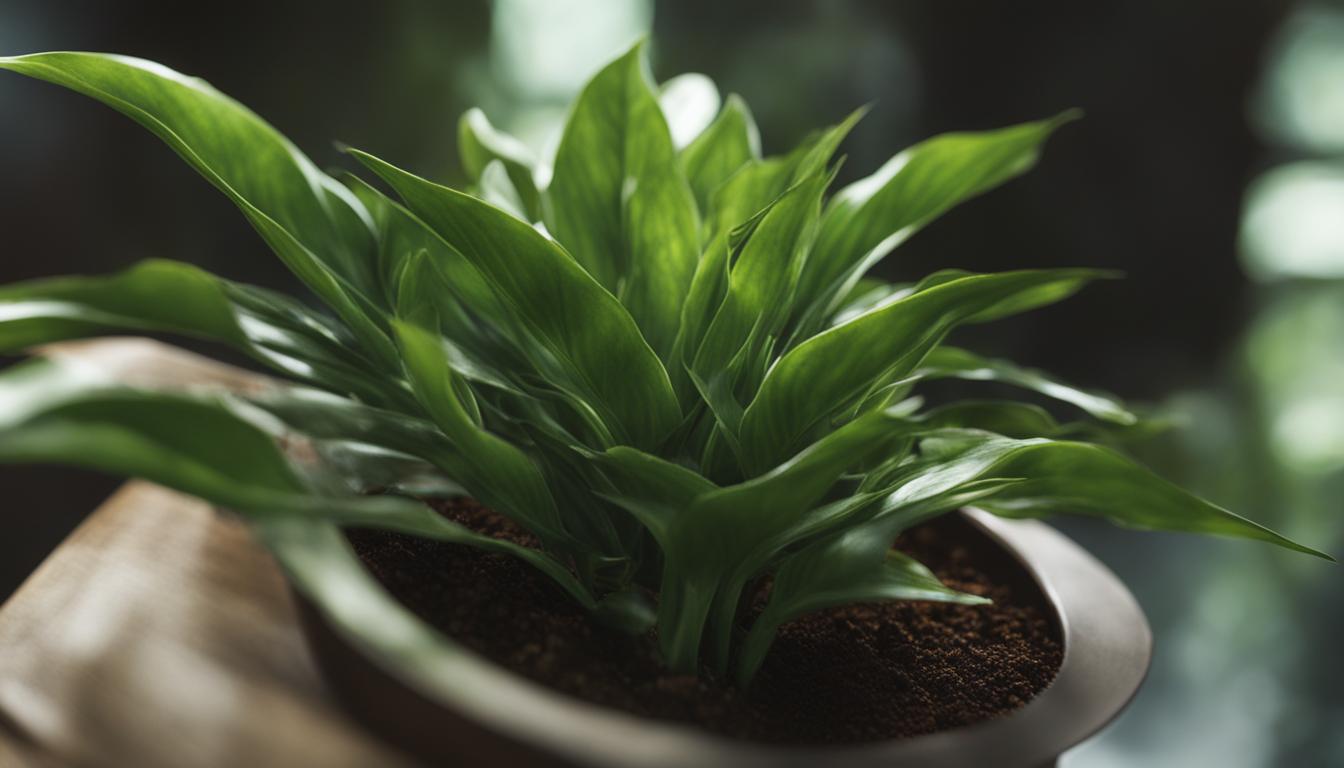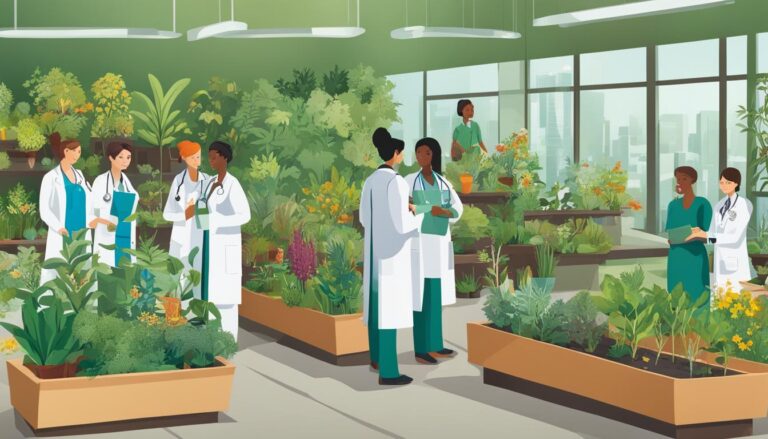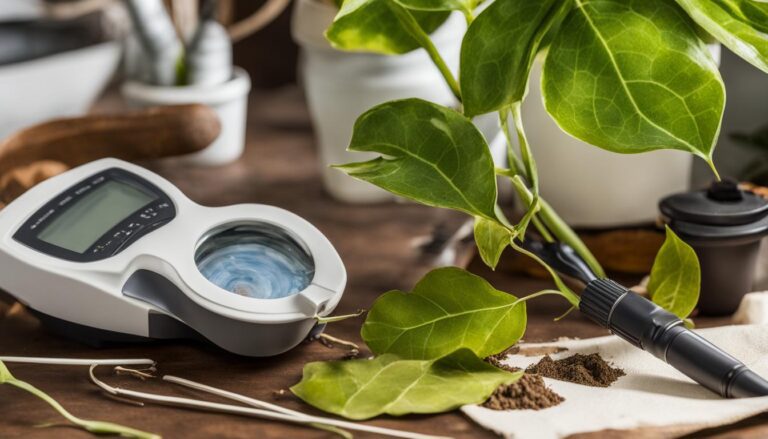
Hey there! Welcome to my guide on fungal plant infections.
Fungal infections are the most common form of plant disease and can affect a variety of plant species. Unlike plants, fungi don’t produce chlorophyll and rely on hyphae, tiny thread-like filaments, to absorb nutrients.
Recognizing the signs of fungal infections, such as mycelia appearing as spots, powder, rust, down, or cotton-like wool, is crucial for effective management.
Now, let’s explore the common origins and examples of pathogenic fungi, learn how to identify fungal infections, and discover preventive measures to keep your plants healthy.
We’ll also discuss various treatment options and delve into the exciting world of biological control and advanced detection techniques. Finally, we’ll understand the importance of plant disease diagnostics and ongoing research to combat fungal infections and ensure thriving plant health.
Now that we’ve set the stage, let’s dive deeper into the fascinating world of fungal plant infections! Stay tuned for more insights and tips to keep your plants healthy and vibrant.
In this article, we’ll dive into the causes, identification, treatment, and prevention of these pesky plant diseases. So, whether you’re an avid gardener, a plant enthusiast, or just want to keep your green friends healthy, this guide is for you.
Key Takeaways:
- Fungal plant infections are common and affect a wide range of plant species.
- Mycelia, appearing as spots, powder, rust, down, or cotton-like wool, are signs of fungal infections.
- Preventing fungal infections involves good plant hygiene practices and careful plant selection.
- Treatment options include chemical fungicides, removal of infected plant material, and biological control methods.
- Endophytic fungi and advanced techniques like image processing and deep learning contribute to disease management.
Common Origins and Examples of Pathogenic Fungi
Pathogenic fungi are a leading cause of fungal infections in plants. These microorganisms can thrive on both living and deceased plant matter, leading to the development of disease in their hosts. Understanding the common origins and examples of pathogenic fungi is crucial in identifying and managing fungal infections effectively.
Some common examples of fungal infections include powdery mildew, verticillium wilt, and downy mildew. Powdery mildew appears as a white powdery coating on plant surfaces, while verticillium wilt causes wilting and yellowing of leaves.
Downy mildew, on the other hand, manifests as a yellowish growth on the undersides of leaves. Each of these fungal infections is caused by different pathogenic fungi and can affect a wide range of plant species.
To successfully combat fungal infections, it is important to accurately identify the specific fungal pathogen causing the disease. This allows for targeted treatment strategies and reduces the risk of ineffective or harmful interventions.
Pathogenic fungi can have varying life cycles and methods of infection, making precise identification essential for effective disease management.
“Pathogenic fungi are a significant threat to plant health, causing widespread damage and economic losses in the agricultural industry. By understanding the common origins and examples of these fungi, we can implement proactive measures to prevent and manage fungal infections in plants.”
| Fungal Pathogen | Common Name of Disease | Affected Plants |
|---|---|---|
| Powdery mildew | White powdery coating on plant surfaces | Various plant species, including roses, cucumbers, and grapes |
| Verticillium spp. | Wilting and yellowing of leaves | Various trees, vegetables, and field crops |
| Downy mildew | Yellowish growth on the undersides of leaves | Grapes, lettuce, and other leafy vegetables |
Summarizing the Common Origins and Examples of Pathogenic Fungi
Pathogenic fungi can cause detrimental infections in plants, affecting various parts of the plant, such as leaves, stems, and fruits. Understanding the common origins and examples of these pathogens is essential for efficient disease management.
By accurately identifying the specific fungus causing the infection, targeted treatments can be implemented, reducing the risk of ineffective interventions and further spread of the disease.
Some common examples of pathogenic fungi include powdery mildew, verticillium wilt, and downy mildew. These fungal infections can impact a wide range of plant species and require specific treatment approaches.
By recognizing the signs and symptoms of these infections and understanding their life cycles, farmers and gardeners can take proactive measures to prevent the spread of fungal diseases and maintain healthy plants.
With this knowledge, we can better protect our plants from the damaging effects of fungal infections and promote sustainable plant health. By implementing preventive measures, accurately identifying pathogens, and employing targeted treatments, we can minimize the impact of fungal diseases on our plant species and ensure their continued well-being.
Identifying Fungal Infections
Identifying fungal infections in plants is crucial for effective disease management. By recognizing the signs and symptoms of fungal diseases, we can take timely action to prevent further spread and mitigate their impact.
Common signs of fungal infections include the appearance of white spots, powdery patches, or clusters of hyphae on leaves, stems, flowers, or fruit. Plants affected by fungal infections may exhibit wilting, yellowing, or stunted growth.
Accurate identification of the specific fungal pathogen is essential for implementing appropriate treatment strategies. Examining the characteristics of the infection, such as the appearance of mycelia or the type of effusion, can help narrow down the possible pathogens.
It is recommended to consult diagnostic laboratories or plant health experts to confirm the presence of specific fungal pathogens and obtain tailored advice for treatment.
Exemplary Fungal Infections
Powdery mildew is a common fungal infection characterized by the presence of white powdery patches on leaves, stems, and flowers. Downy mildew, on the other hand, appears as yellow, green, or gray patches on the undersides of leaves.
These are just a few examples of fungal infections, and it is important to note that different fungi may attack different types of plants. Therefore, accurate identification is crucial for effective disease management.”
| Fungal Infection | Signs and Symptoms |
|---|---|
| Powdery Mildew | White powdery patches on leaves, stems, flowers |
| Downy Mildew | Yellow, green, or gray patches on the undersides of leaves |
| Verticillium Wilt | Yellowing and wilting of leaves, vascular discoloration |

Identifying and understanding the specific fungal pathogens causing plant diseases is an essential step in effective disease management. By recognizing the signs, symptoms, and characteristics of fungal infections, we can take the necessary steps to protect our plants and implement appropriate treatment strategies.
Preventing Fungal Infections in Plants
When it comes to maintaining the health of your plants, preventing fungal infections is essential. By implementing proper plant hygiene practices, you can create an environment that is less susceptible to fungal pathogens. Here are some key strategies to consider:
- Water plants from beneath the foliage: Watering plants from above can create a moist environment on the leaves, providing a favorable condition for fungal spores to germinate. To prevent this, water your plants at the base, directly into the soil.
- Ensure good air circulation: Proper spacing between plants allows for better airflow, reducing the risk of fungal infections. Avoid overcrowding your garden or placing plants too close together.
- Promptly remove infected plant material: If you notice any signs of fungal infection, such as spots or patches on leaves, stems, or fruit, remove and dispose of the infected plant material immediately. This will help prevent the spread of fungal pathogens to other plants.
- Be cautious when purchasing plants: Not all suppliers ensure disease-free products. Before purchasing new plants, inspect them carefully for any signs of fungal infections. It’s better to be safe than sorry!
By following these preventive measures, you can minimize the risk of fungal infections in your plants and promote their overall health. Remember, early detection and intervention are key to effectively managing fungal diseases.
Common Fungal Pathogens and Plant Hygiene Practices
| Fungal Pathogen | Plant Hygiene Practices |
|---|---|
| Powdery Mildew | Water plants from beneath the foliage Ensure good air circulation Remove and dispose of infected plant material promptly Inspect new plants for signs of infection |
| Downy Mildew | Water plants from beneath the foliage Ensure good air circulation Remove and dispose of infected plant material promptly Inspect new plants for signs of infection |
| Botrytis Blight | Water plants from beneath the foliage Ensure good air circulation Remove and dispose of infected plant material promptly Inspect new plants for signs of infection |
Implementing these plant hygiene practices can go a long way in preventing fungal infections and ensuring the overall health and vitality of your plants. Taking proactive steps towards disease prevention will save you time and effort in the long run.
Treating Fungal Plant Diseases
When it comes to treating fungal plant diseases, there are various approaches that can be taken depending on the specific fungal pathogen and the severity of the infection. One common method is to use chemical treatments such as fungicides.
These commercial fungicides are designed to target and eliminate fungal pathogens, helping to control the spread of the disease.
It is important to note that not all fungi are susceptible to chemical treatment, and some fungicides may not be suitable for use on edible crops. It is crucial to verify the effectiveness of the chemical treatment for the specific fungal pathogen causing the disease.
In some cases, removing and destroying infected plant material may be the only solution to prevent further spread of the fungus. This can help eliminate the source of the infection and reduce the risk of the disease affecting other plants in the vicinity.
Treating Fungal Plant Diseases – A Disease-Specific Approach
Another important aspect of treating fungal plant diseases is adopting a disease-specific approach. Different fungal pathogens require different treatment strategies, as they may vary in their susceptibility to certain treatments.
It is crucial to accurately identify the specific fungal pathogen causing the disease to implement the most effective treatment.
For example, some fungal infections may respond well to cultural practices such as pruning affected plant parts, improving air circulation, and avoiding overhead watering. These practices help create an unfavorable environment for fungal growth and can aid in reducing the severity of the infection.
In certain cases, biological control methods can be employed to manage fungal plant pathogens. Beneficial fungi, such as Trichoderma, have been found to suppress fungal diseases and can be used as biocontrol agents.
These methods provide an eco-friendly and sustainable approach to disease management, without relying solely on chemical treatments.
Comparison of Chemical Treatments and Disease-Specific Approaches
| Treatment Method | Advantages | Disadvantages |
|---|---|---|
| Chemical Treatments | – Effective in controlling certain fungal pathogens – Wide availability of commercial fungicides | – Not all fungi are susceptible to chemical treatment – Some fungicides may not be suitable for edible crops |
| Disease-Specific Approaches | – Targeted treatment based on specific fungal pathogen – Can include cultural practices and biological control methods | – Requires accurate identification of the fungal pathogen – May not be effective for all fungal infections |
Overall, treating fungal plant diseases requires a comprehensive approach that considers the specific fungal pathogen, the severity of the infection, and the suitability of different treatment methods. By combining chemical treatments, disease-specific approaches, and cultural practices, it is possible to effectively manage fungal infections and promote healthy plant growth.
Biological Control of Fungal Pathogens
When it comes to managing fungal plant pathogens, biological control methods offer a promising and eco-friendly solution. Beneficial fungi, such as Trichoderma, can be utilized as biocontrol agents to suppress fungal diseases effectively. These beneficial fungi compete with pathogenic fungi for resources, reducing their growth and spread.
Microbial biocontrol strategies can be employed to protect plants against fungal infections. Certain bacteria have shown efficacy in inhibiting the growth of fungal pathogens, offering a natural and sustainable approach to disease management.
By harnessing the power of these biological control agents, farmers and growers can reduce their reliance on chemical treatments and promote a healthier, more balanced ecosystem. Implementing such strategies can help mitigate the impact of fungal diseases and contribute to sustainable agriculture practices.
The Role of Beneficial Fungi in Biocontrol
Beneficial fungi, such as Trichoderma, play a crucial role in biocontrol efforts against fungal plant pathogens. These fungi have a remarkable ability to outcompete and inhibit the growth of harmful fungi through various mechanisms.
“Trichoderma, a well-studied biocontrol agent, produces enzymes that degrade the cell walls of pathogenic fungi, disrupting their growth and causing their death. Trichoderma can activate the plant’s defense mechanisms, enhancing its resistance to fungal infections.”
The use of beneficial fungi like Trichoderma not only helps manage fungal diseases but also promotes overall plant health and productivity. With their eco-friendly nature and proven effectiveness, these biocontrol agents are gaining recognition as valuable tools in the fight against fungal pathogens.
Microbial Biocontrol Strategies
In addition to beneficial fungi, microbial biocontrol strategies involve the use of certain bacteria to combat fungal infections. These bacteria can produce antimicrobial compounds or compete with fungal pathogens for resources, limiting their growth and spread.
One example of microbial biocontrol is the use of Bacillus subtilis, a bacterium known for its antagonistic activity against various plant pathogens, including fungi. Bacillus subtilis produces antimicrobial peptides that inhibit the growth of fungal pathogens, providing a natural defense mechanism for plants.
Integrating these microbial biocontrol strategies into plant disease management practices offers a promising alternative to chemical treatments. By harnessing the power of nature, we can effectively control fungal pathogens while minimizing the impact on the environment and human health.

Comparison of Biological Control Method
| Biological Control Agents | Advantages | Limitations |
|---|---|---|
| Beneficial Fungi | Effective against a wide range of fungal pathogens; promote plant growth; eco-friendly | May require specific environmental conditions; need to establish proper colonization |
| Microbial Biocontrol | Natural and sustainable approach; contribute to overall plant health; reduce chemical reliance | Specific strains may have limitations against certain fungal species; require proper application techniques |
Endophytic Fungi and Plant Disease Management
Endophytic fungi play a crucial role in plant disease management. These fungi reside within plant tissues without causing harm and have been found to produce natural compounds with disease-fighting properties.
Their ecological significance extends beyond disease suppression, as they can also promote plant growth and enhance plant resistance against fungal infections.
The presence of endophytic fungi in plants offers a natural and sustainable approach to managing fungal diseases. By harnessing the power of these beneficial fungi, we can reduce our reliance on chemical treatments and promote the health and resilience of our plants.
“Endophytic fungi have emerged as potential sources of bioactive compounds with antifungal properties. These natural products, derived from the symbiotic relationship between the fungi and the plant, hold great promise for developing eco-friendly solutions to combat fungal diseases in crops.”
Unlocking the Potential of Endophytic Fungi
Research on endophytic fungi has revealed their vast potential in plant disease management. Scientists are studying the diversity of these fungi and the natural compounds they produce, aiming to develop innovative strategies for disease control.
These efforts can lead to the discovery of new bioactive compounds that can be used as natural fungicides or disease-resistant traits that can be incorporated into crop breeding programs.
In addition, understanding the ecological interactions between endophytic fungi, plants, and pathogens can provide valuable insights into the mechanisms of disease resistance. This knowledge can help us develop targeted approaches for managing fungal diseases and protecting the health of our plants.
Endophytic fungi offer a unique and sustainable solution for plant disease management. Their ecological significance, coupled with the production of natural compounds with disease-fighting properties, has the potential to revolutionize the way we approach fungal infections in plants.
By further exploring the diversity and interactions of endophytic fungi, we can unlock new strategies to protect our crops and promote a healthier, more resilient agricultural system.
Advanced Techniques for Plant Disease Detection
When it comes to detecting and managing fungal diseases in plants, advanced techniques are revolutionizing the field. Automated detection techniques, such as image processing and deep learning models, are paving the way for more efficient and accurate identification of plant disease symptoms.
By analyzing images of plants, these techniques can quickly identify signs of fungal infections, enabling early detection and prompt intervention.
Image processing algorithms play a crucial role in the analysis of plant images. They can extract key features and patterns from images, allowing for the identification of specific disease symptoms.
Deep learning models, on the other hand, use artificial neural networks to learn from large datasets, enabling them to make accurate predictions based on visual information.
These advanced techniques offer numerous benefits in plant disease detection. They provide a non-invasive and cost-effective method for monitoring plant health, reducing the need for manual inspection.
They can help researchers and farmers identify specific fungal pathogens more accurately, enabling targeted treatment strategies. By detecting diseases at an early stage, these techniques have the potential to prevent significant damage to crops and improve overall plant health.
“The use of image processing and deep learning models in plant disease detection represents a significant advancement in our ability to manage fungal infections,” says Dr. Emily Johnson, a plant pathologist. “These techniques allow us to quickly and accurately assess the health of plants, empowering farmers to take proactive measures in preventing the spread of diseases.”

Advantages of Advanced Techniques
- Early detection of fungal infections
- Improved accuracy in identifying disease symptoms
- Cost-effective and non-invasive monitoring
- Targeted treatment strategies
- Prevention of crop damage
Limitations and Future Developments
While advanced techniques show great promise, there are still limitations to consider. The accuracy of image processing and deep learning models heavily relies on the quality of input images and the availability of a diverse dataset for training. There may be challenges in applying these techniques to different plant species due to variations in disease symptoms.
Ongoing research and advancements in technology are addressing these limitations. Improvements in image capture technology and the development of more comprehensive datasets are enhancing the accuracy and reliability of these techniques.
Collaborations between researchers and industry professionals are driving innovation in plant disease detection, ultimately leading to more effective management strategies.
| Advantage | Limitation |
|---|---|
| Early detection of fungal infections | Variations in disease symptoms among different plant species |
| Improved accuracy in identifying disease symptoms | Reliance on quality input images and diverse training datasets |
| Cost-effective and non-invasive monitoring | |
| Targeted treatment strategies | |
| Prevention of crop damage |
Integrated Pest Management for Fungal Diseases
In the management of fungal diseases, integrated pest management (IPM) offers a comprehensive approach that considers the entire farming system. By incorporating cultural control strategies, disease prediction models, and sustainable practices, IPM aims to effectively manage fungal diseases while reducing reliance on chemical treatments.
Cultural control strategies play a crucial role in IPM for fungal diseases. These strategies focus on preventive measures such as crop rotation, maintaining good soil health, and practicing farm sanitation. Crop rotation helps break the disease cycle by planting different crops in a specific sequence, reducing the build-up of fungal pathogens.
Maintaining soil health through proper nutrient management and organic amendments promotes stronger plants that are more resistant to fungal infections.
Another important aspect of IPM is the use of disease prediction models. These models take into account weather conditions and other environmental factors to predict disease outbreaks.
By monitoring these predictions, farmers can make informed decisions regarding the optimal timing for disease control measures, such as fungicide applications.
This targeted approach maximizes the effectiveness of treatments while minimizing their impact on the environment.
Benefits of Integrated Pest Management for Fungal Diseases:
- Reduces reliance on chemical treatments
- Promotes sustainable and environmentally-friendly practices
- Enhances crop health and resilience
- Minimizes economic losses due to fungal infections
- Improves long-term management of fungal diseases
By implementing integrated pest management strategies, farmers can effectively manage fungal diseases in a sustainable and holistic manner. This approach not only protects crop health but also contributes to the overall sustainability of agricultural systems.
Cultural Control Strategies for Fungal Disease Management
| Strategy | Description |
| Crop rotation | Planting different crops in a specific sequence to disrupt the disease cycle and reduce the build-up of fungal pathogens. |
| Good soil health | Maintaining nutrient-rich soil through proper nutrient management and organic amendments to promote stronger plants with increased resistance to fungal infections. |
| Farm sanitation | Practicing good hygiene on the farm, including removing and disposing of infected plant material promptly, to prevent the spread of fungal pathogens. |
| Table: Cultural control strategies for fungal disease management | |
“Integrated pest management for fungal diseases is a sustainable approach that maximizes disease control while minimizing environmental impact. By implementing cultural control strategies and utilizing disease prediction models, farmers can effectively manage fungal infections in a holistic and eco-friendly manner.”
Importance of Plant Disease Diagnostics and Research
When it comes to managing fungal plant infections, accurate plant disease diagnostics are absolutely essential. Diagnostic laboratories play a crucial role in identifying and confirming the presence of specific fungal pathogens.
These tests provide valuable information that guides the development of effective treatment strategies. Without proper diagnosis, it can be challenging to tackle fungal infections and protect the health of our plants.
Ongoing research on fungal diseases is also vital for staying ahead in the battle against plant infections. Through continuous study and exploration, researchers can develop innovative approaches to managing fungal diseases.
They can uncover new insights into the behavior of fungal pathogens, which can lead to the development of more targeted and effective management strategies. Research is the driving force behind advancements in plant health and disease management.
Collaboration between researchers, farmers, and agricultural organizations is essential in the fight against fungal infections. By combining their knowledge and expertise, they can work together to develop comprehensive management strategies.
This collaborative effort ensures that the latest research findings are applied in practical ways to protect our crops and promote healthy plants. Together, we can make a significant impact on the prevention and control of fungal diseases.
In conclusion, plant disease diagnostics and research are of utmost importance in managing fungal plant infections. Diagnostic laboratories provide the necessary tools to identify specific fungal pathogens, while ongoing research drives innovation in disease management.
By collaborating and applying their findings, researchers, farmers, and agricultural organizations can work together to develop effective strategies for combatting fungal infections and ensuring the health of our plants.
After reading this, check out our other articles on:
- Identify Plant Diseases: Guide to Protect Your Greenery
- Recognizing and Understanding Plant Virus Symptoms
FAQ
What are the common signs of fungal infections in plants?
Common signs of fungal infections include the appearance of mycelia, which take the form of spots, powder, rust, down, or cotton wool-like effusions on flowers, stems, leaves, and fruit.
What causes fungal infections in plants?
Fungal infections in plants are caused by pathogenic fungi that can live on dead or living flora and fauna and produce disease states in their hosts.
How can I identify fungal infections in plants?
Fungal infections can be identified by recognizing the signs and symptoms, such as white spots, powdery patches, or clusters of hyphae on leaves, stems, flowers, or fruit.
What can I do to prevent fungal infections in plants?
Preventing fungal infections involves implementing good plant hygiene practices, such as watering plants from beneath the foliage, creating proper spacing between plants, and removing infected plant material promptly.
How can I treat fungal plant diseases?
Treating fungal plant diseases can involve using commercial fungicides, removing and destroying infected plant material, or employing biocontrol agents like beneficial fungi.
What are some biological control methods for fungal plant pathogens?
Biological control methods include using beneficial fungi like Trichoderma and employing microbial biocontrol strategies using bacteria to suppress fungal diseases.
How do endophytic fungi contribute to plant disease management?
Some endophytic fungi reside within plant tissues without causing harm and produce natural compounds with disease-fighting properties, enhancing plant resistance against fungal infections.
What advanced techniques are used for plant disease detection?
Advanced techniques like image processing and deep learning models can be used to analyze plant images and identify disease symptoms, aiding in early detection of fungal infections.
What is integrated pest management for fungal diseases?
Integrated pest management considers the entire farming system and involves cultural control strategies, monitoring weather conditions, and employing disease prediction models to effectively manage fungal diseases.
How important is plant disease diagnostics and research?
Accurate plant disease diagnostics and ongoing research are crucial for effective management of fungal plant infections and developing innovative approaches to improve plant health.







2 Comments
Comments are closed.